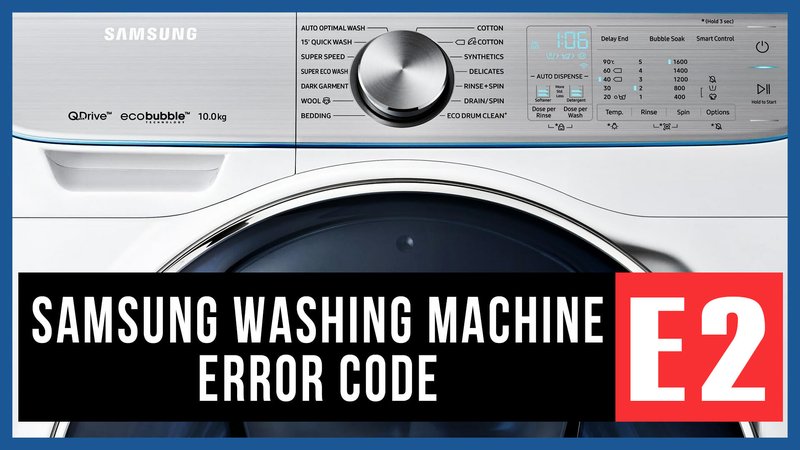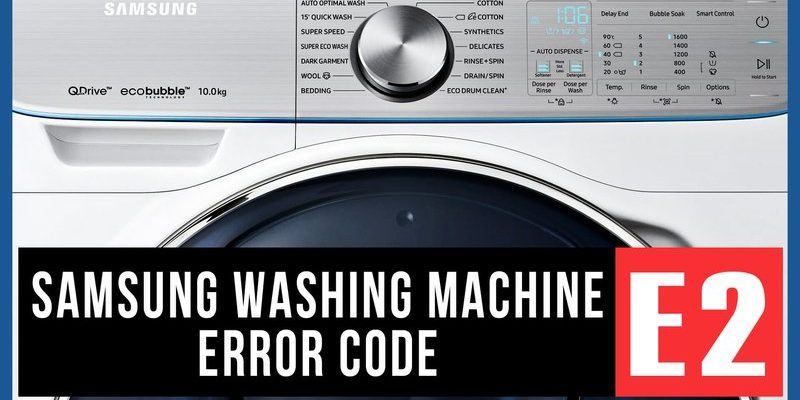
Let’s break it down. Error codes on washing machines are like messages on your smartphone alerting you to a problem. They’re there to inform you of what’s wrong so you can fix it before it turns into a bigger issue. The “E2” code on a Samsung washing machine typically indicates a drainage problem. But don’t worry; understanding what this means and how to address it can help you feel more at ease and confident in getting your laundry back on track.
Understanding the E2 Error Code
So, what exactly is this E2 error? Think of it as your washing machine signaling for help. The E2 error typically occurs when the machine struggles to drain water properly. Imagine a clogged kitchen sink; the water just won’t go down because something’s stuck in the pipes. Similarly, if there’s an issue with the drainage system of your washing machine, it will throw up an E2 error code.
The drainage system of a washing machine involves several components, including the drain pump, hose, and filter. If any of these parts are blocked or malfunctioning, the water can’t be drained out efficiently, triggering the E2 error. Sometimes it could be as simple as a sock that found its way into the wrong compartment, or it could be more mechanical, like a faulty pump.
While this might sound a bit technical, the good news is that some causes of the E2 error can be resolved without calling a professional. By following a few troubleshooting steps—like checking for clogs in the hose or ensuring the pump isn’t obstructed—you might be able to clear the error yourself. However, if the problem persists, it might be time to contact a technician.
Is It Safe to Continue Using the Washer?
You might be wondering, “Can I still use my machine, or should I wait until it’s fixed?” The short answer is, it’s best not to use the washing machine while the E2 error is unresolved. Here’s why: continuing to operate the machine with a known drainage issue can lead to more significant problems down the line, like water overflowing, which could damage your floor or the machine itself.
Using the washing machine with its drainage system compromised is like trying to drive a car with a flat tire. Sure, you might be able to move, but it’s risky and could cause further damage. The safer route is to halt use until the problem is identified and fixed. This approach not only prevents potential water damage but also ensures the longevity of your appliance.
If you need to have clean clothes while dealing with the E2 error, consider alternative methods like hand washing or using a laundromat. These temporary solutions can tide you over until your washing machine is back in action.
Steps to Fix the E2 Error
Now, let’s get into some practical steps to take when faced with the E2 error. First, unplug the washing machine to prevent any electrical hazards and give yourself a clear view of what might be going wrong. Start by checking the drain hose for any obvious blockages or kinks. The hose is like the exit highway for water. If it’s blocked, the water backs up, leading to the error.
If the hose seems clear, the next step is to inspect the drain filter. Think of this filter like a coffee filter; it catches the bits you don’t want going through the machine. Over time, lint or small items can clog this filter, causing drainage issues. Cleaning it out might just solve the problem.
If these steps don’t resolve the issue, the fault may lie with the drain pump. While this is more technical and might require a professional to assess, knowing the possible causes can help you make informed decisions about repairs. Once everything is back in working order, remember to regularly check and maintain these components to prevent future E2 errors.
Preventing Future E2 Errors
To prevent the E2 error from cropping up again, consider implementing some regular maintenance tips. Periodically inspect the drain hose and ensure it’s not twisted or blocked. You can also make it a habit to check the drain filter every month to clear out any buildup.
Additionally, be mindful of the laundry you’re doing. Items with lots of lint, like towels and fleece, can cause buildup faster, so you might want to clean the filter more often when washing these materials. Avoid overloading the machine as well; too many clothes at once can make it harder for water to drain properly.
Finally, keep an eye on your machine’s performance. If you notice it’s draining more slowly than usual or making unusual noises, address these issues promptly to avoid seeing that dreaded E2 message again.
By following these preventative steps and understanding how to address the E2 error, you can rest easy knowing you’re taking good care of your washing machine and ensuring it runs smoothly for years to come.
